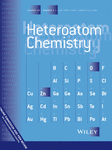Synthesis, Spectral Characterization of Four Symmetrical and Unsymmetrical Organotellurium(II) Compounds: O−H…N, CH…π, and CH…O Secondary Interactions in X-Ray Crystal Structures of 4-MeOC6H4TeCH2CH2CH2N═C(CH3)C6H4-2-OH (1) and Te[CH2CH2CH2N═C(CH3)C6H4-2-OH]2 (2)
ABSTRACT
The condensation of 3-(4-methoxyphenyltelluro)propylamine and bis(3-aminopropyl) telluride with 2-hydroxyacetophenone formed two Schiff's bases 2-[1-(3-(4-methoxyphenyltellanyl)propylimino)ethyl]phenol (1) and Bis 2-[1-(3-iminopropyltellanyl)ethyl]phenol (2), respectively. The reduction of 1 and 2 gave compounds 2-[1-(3-(4-methoxyphenyltellanyl)propylamino)ethyl]phenol (3) and Bis 2-[1-(3-aminopropyltellanyl)ethyl]phenol (4), respectively. These four new organotellurium compounds (1–4) were characterized by 1H and 13C NMR and FTIR spectroscopies and atomic absorption spectrophotometer (AAS) (Te). The conductance and molecular weights and composition by elemental analysis (C, H, and N) of 1 and 2 were determined. The compound 4 was also characterized by 13C DEPT-135 NMR spectrum. The compounds 1 and 3 are unsymmetrical, and 2 and 4 are symmetrical type of telluroethers. The single crystals of 1 and 2 were grown, and their molecular structures were determined by single crystal X-Ray diffraction. The ArC–Te bond length in 1 was found 2.117(7) Å. The RC–Te bond length in 1 is 2.141(5) Å and in 2 is 2.146(5) and 2.150(6) Å. The >C═N bond lengths in 1 and 2 were between 1.278(6) and 1.295(6) Å. There exists intramolecular O−H…N hydrogen bonding [between 1.758(4) and 1.792(4) Å] in 1 and 2. In compound 2, these nonbonded interactions result in the formation of a  (34) dimeric ring. CH…O [2.505(4)–2.516(3) Å] in 1 and 2 and CH…π [2.61(5) and 2.89(4) Å] secondary interactions are also present in 2.
(34) dimeric ring. CH…O [2.505(4)–2.516(3) Å] in 1 and 2 and CH…π [2.61(5) and 2.89(4) Å] secondary interactions are also present in 2.




